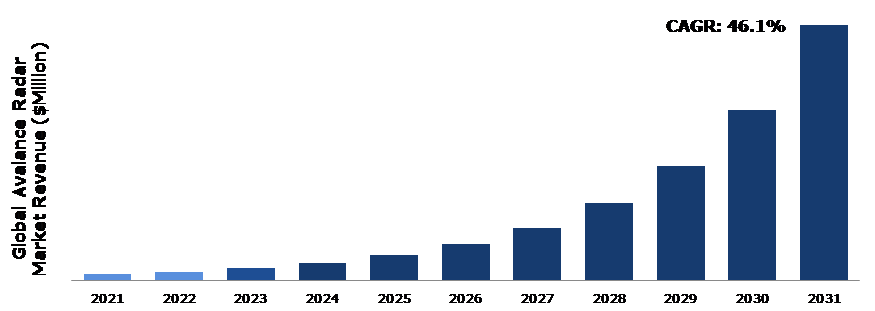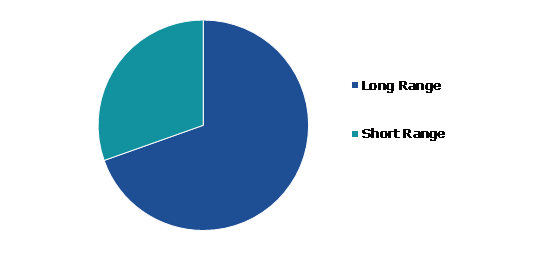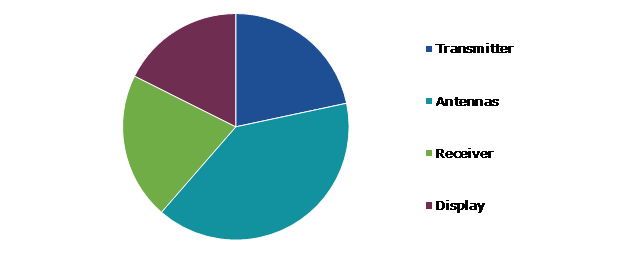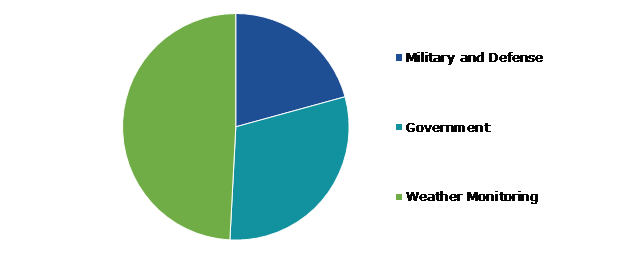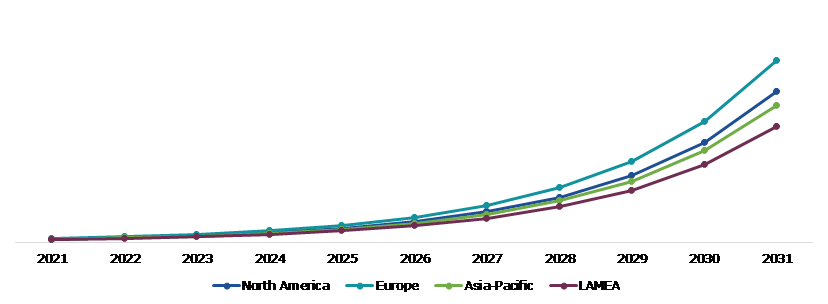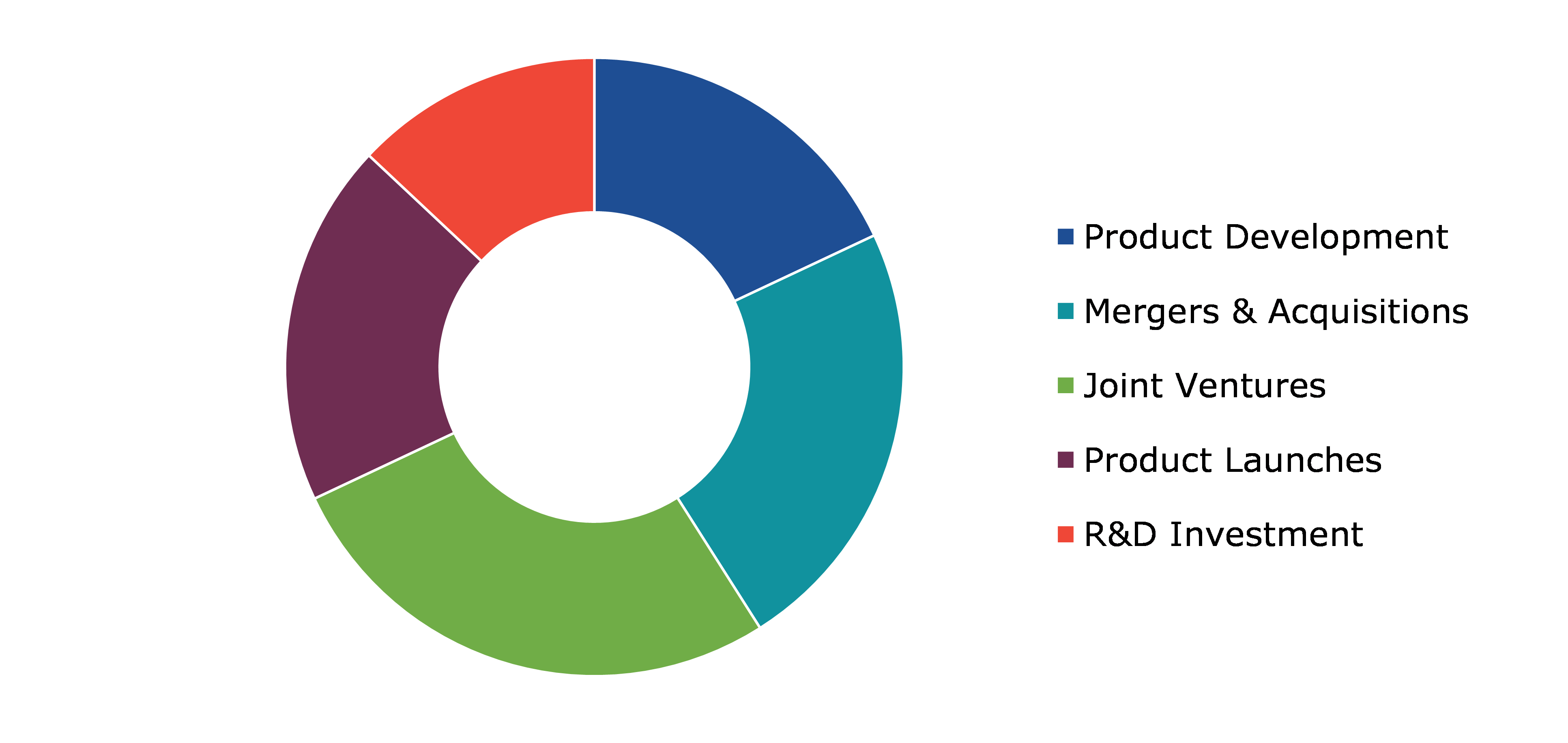Avalanche Radar Market Report
RA08542
Avalanche Radar Market by Type (Long Range and Short Range), Component (Transmitter, Antennas, Receiver, and Display), End-user (Military and Defense, Government, and Weather Monitoring), and Regional Analysis (North America, Europe, Asia-Pacific, and LAMEA): Global Opportunity Analysis and Industry Forecast, 2022-2031
Global Avalanche Radar Market Analysis
The Global Avalanche Radar Market Size was $1,501.4 million in 2021 and is predicted to grow with a CAGR of 5.0%, by generating a revenue of $64,412.5 million by 2031.
Global Avalanche Radar Market Synopsis
Rising security worries, combined with increased defense funding, are stimulating the avalanche radar industry development potential. The spread of technology is having a favorable impact on the industry and is contributing to the creation of lightweight radars. Strategic collaborations among industry participants, as well as a greater emphasis on border protection activities, are significantly increasing demand for avalanche radar systems.
A highly competent and experienced crew is required for avalanche radar systems to interpret correct findings and conclusions from the acquired data. Furthermore, the high costs of implementing worker training programmes are expected to restrict new entrants into this market. As a result, the expansion of the avalanche radar market is expected to be restricted.
Modernization activities of military equipment and legacy systems around the world are opening up new business opportunities. The avalanche radar companies are expected to see increased demand as a result of an increase in terrorism, inter-country disputes, border infiltrations, and attack-prone frontiers. Military radars improve detecting, tracking, monitoring, ground mapping, and warning against stealth aircraft and weaponry, resulting in increased security.
Avalanche Radar Overview
The avalanche radar is intended to provide early warning of avalanches as well as to sound an alarm. Roads and railway lines are automatically blocked in the case of an avalanche, and inhabitants in the danger region are reliably warned. Avalanche radar is also used in avalanche control operations to confirm the success of an artificially produced avalanche. It is especially difficult to detect avalanches without radar in the dark or during terrible weather (fog, snow, rain).
COVID-19 Impact on Global Avalanche Radar Market
In March 2020, the World Health Organization declared COVID-19 as a pandemic, which had an adverse effect on supply chains, output levels, and travel restrictions in addition to causing disruptions in the financial markets. Every firm has been influenced by a series of strange events brought on by the coronavirus pandemic. Individuals, society, industry, and the global economy are all still being impacted by the COVID-19 disaster. The supply of raw materials was stopped as a result of the production segments being severely affected. The avalanche radar market has so experienced a setback.
The novel coronavirus has impacted the global avalanche radar sector, among others. This is mostly due to closures in the industrial sector and disruptions in supply chains. Furthermore, due to strict federal restrictions and transportation limitations, raw material supply has been stopped and delayed, thus impacting industrial segments' capacity to offer the final product. All of these variables contributed to the market's decline during the crisis. The COVID-19 pandemic has had a major impact on the avalanche radar sector, as well as other industries. The coronavirus's uncontrolled spread has forced the shutdown of several industries. As a result, the industry's output and supply networks were impeded, resulting in a decrease in market growth.
Growing Applications of Avalanche Radars in Military and Defense Sector to Drive the Market Growth
Avalanche radar is becoming increasingly popular. The market is expected to increase significantly throughout the estimated duration, particularly in the defense and military sectors around the world. Furthermore, the increased use of radar by weather forecasters to improve avalanche prediction is likely to boost avalanche radar demand during the projection period. Furthermore, rising technical improvements in the weather monitoring industry are expected to generate significant potential prospects for the avalanche radar market during the study period. However, the high cost of worker training and a shortage of competent and experienced personnel may hinder market expansion over the forecast period.
To know more about global avalanche radar market drivers, get in touch with our analysts here.
High Cost in Expenditure on Avalanche Radars to Restrain the Market Growth
The cost of embedding the avalanche radar devices into a country's defense networks is significant. Military radars must be compatible with a variety of fire control platforms, command and controlling systems, missiles, and anti-aircraft guns. These systems are extremely expensive to launch and maintain. As a result, the high cost and time required for the manufacture and implementation of these systems are likewise prohibitively expensive.
Use of Avalanche Radar for Weather and Terrorist Attack Monitoring to Drive Excellent Opportunities
Avalanche radar is a critical component of global militaries' surveillance systems. Growing territorial disputes and adversary threats are driving numerous countries to spend extensively in surveillance technologies in order to limit reliance, identify infiltration, and respond promptly. As a result of increased use of unmanned aerial vehicles (UAVs), stealth aircraft, hypersonic missiles, and cyber warfare systems, some countries have had to improve their radar capabilities. Advances in range, detection, identification, and integration with other sensors, as well as flexibility to new missions, platforms, and conditions, are fueling global demand for new military radars.
To know more about global avalanche radar market opportunities, get in touch with our analysts here.
Global Avalanche Radar Market, by Type
Based on type, the market has been divided into short range and long range. Among these, the long range sub-segment accounted for the highest market share and is estimated to show the fastest growth during the forecast period.
Global Avalanche Radar Market Size, by Type 2021
Source: Research Dive Analysis
The Long-Range sub-type accounted for the largest market share in 2021 and is anticipated to show the fastest growth during the forecast period. Long-range avalanche radar was erected in Ischgl, Austria, with the aim of validating planned avalanche releases and collecting information regarding spontaneous avalanche activity. The radar, a standard operating instrument used by safety personnel, has a significant advantage in detecting even minor avalanche incidents. The closer the range to the radar antenna and the better the weather conditions (no rain, no snowfall), the smaller the measurable avalanches [events of a few hundred m3 (cubic meter) were recorded at a distance of 1.5 km].
Global Avalanche Radar Market, by Component
Based on component, the market has been divided into transmitter, antennas, receiver, and display. Among these, the antennas sub-segment accounted for the highest revenue share in 2021 and is anticipated to show the fastest CAGR during the forecast period.
Global Avalanche Radar Market Share, by Component, 2021
Source: Research Dive Analysis
The Antennas sub-segment accounted for the largest market share in 2021. The antenna component dominated the global 3D and 4D military radars owing to manufacturers' focus on developing technologically advanced antennas such as active scanning array antenna systems for military uses. Antenna size decrease while maintaining strong effectiveness and wideband features with wide bandwidths across all working frequency bands is highly demanding. Utilizing high-frequency structure simulator (HFSS) software, the suggested antenna is developed, modelled, and optimized, and a prototype is built to evaluate its electromagnetic performance.
Global Avalanche Radar Market, by End-user
Based on end-user, the market has been divided into military and defense, government, and weather monitoring. Among these, the weather monitoring sub-segment accounted for highest revenue share in 2021.
Global Avalanche Radar Market Forecast, by End-user, 2021
Source: Research Dive Analysis
The weather monitoring sub-segment accounted for the largest market share in 2021. Weather monitoring radar, also called weather surveillance radar (WSR) and Doppler weather radar, is a type of radar used to find precipitation, estimate its velocity, and determine its type. It is also known as weather surveillance radar (WSR) and Doppler weather radar (rain, snow, hail etc.). Current weather radars are predominantly pulse-Doppler radars that can detect rain droplet motion as well as precipitation intensity. Both sorts of data can be used to predict storm structure and the potential for severe weather.
Global Avalanche Radar Market, Regional Insights
The avalanche radar market was investigated across North America, Europe, Asia-Pacific, and LAMEA.
Global Avalanche Radar Market Size & Forecast, by Region, 2021-2031 (USD Million)
Source: Research Dive Analysis
The Market for Avalanche Radar in Europe to be the Most Dominant
The Europe region held the largest market share in 2021. Avalanches that have been released are difficult to respond to for broad avalanche forecasting zones, particularly under severe weather conditions. This adds a large amount of uncertainty to Europe regional avalanche forecasts. The region has devised a novel solution to this problem. An autonomous processing chain was developed that, approximately one hour after Sentinel-1 image capture, downloads the radar satellite images, runs an avalanche identification and tracking algorithm, and outputs detected avalanches as well as location, timing, and extent information. Data from Sentinel-1 is freely and routinely available, regardless of light or weather conditions. As a result, practical avalanche activity monitoring became feasible and was tested in four Norwegian forecasting zones.
Competitive Scenario in the Global Avalanche Radar Market
Investment and agreement are common strategies followed by major market players. For instance, GEOPRAEVENT AG, a Hexagon company, completed the world's largest avalanche detection system in Canada in June 2019. These avalanches are being constructed in Rogers Pass, Canada. GEOPRAEVENT AG provides four avalanche radars among the detection equipment, one of which has been operational since November 2018.
Source: Research Dive Analysis
Some of the leading avalanche radar market players are Geobrugg AG, Wyssen Avalanche Control AG, GEOPRAEVENT AG, and L.B. Foster Company.
| Aspect | Particulars |
| Historical Market Estimations | 2020 |
| Base Year for Market Estimation | 2021 |
| Forecast Timeline for Market Projection | 2022-2031 |
| Geographical Scope | North America, Europe, Asia-Pacific, and LAMEA |
| Segmentation by Type |
|
| Segmentation by Component |
|
| Segmentation by End-use Industry |
|
| Key Companies Profiled |
|
Q1. What is the size of the global avalanche radar market?
A. The size of the global avalanche radar market was over $1,501.4 million in 2021 and is projected to reach $64,412.5 million by 2031.
Q2. Which are the major companies in the avalanche radar market?
A. Geobrugg AG, Wyssen Avalanche Control AG, GEOPRAEVENT AG, and L.B. Foster Company are some of the key players in the global avalanche radar market.
Q3. Which region, among others, possesses greater investment opportunities in the near future?
A. The Europe region possesses great investment opportunities for investors to witness the most promising growth in the future.
Q4. What will be the growth rate of the Europe avalanche radar market?
A. Europe avalanche radar market is anticipated to grow at 46.7% CAGR during the forecast period.
Q5. What are the strategies opted by the leading players in this market?
A. Agreement and investment are the two key strategies opted by the operating companies in this market.
Q6. Which companies are investing more on R&D practices?
A. Geobrugg AG, Wyssen Avalanche Control AG, GEOPRAEVENT AG, and L.B. Foster Company are the companies investing more on R&D activities for developing new products and technologies.
1.Research Methodology
1.1.Desk Research
1.2.Real time insights and validation
1.3.Forecast model
1.4.Assumptions and forecast parameters
1.4.1.Assumptions
1.4.2.Forecast parameters
1.5.Data sources
1.5.1.Primary
1.5.2.Secondary
2.Executive Summary
2.1.360° summary
2.2.By Type trends
2.3.By Component trends
2.4.By End-user trends
3.Market overview
3.1.Market segmentation & definitions
3.2.Key takeaways
3.2.1.Top investment pockets
3.2.2.Top winning strategies
3.3.Porter’s five forces analysis
3.3.1.Bargaining power of consumers
3.3.2.Bargaining power of suppliers
3.3.3.Threat of new entrants
3.3.4.Threat of substitutes
3.3.5.Competitive rivalry in the market
3.4.Market dynamics
3.4.1.Drivers
3.4.2.Restraints
3.4.3.Opportunities
3.5.End-user landscape
3.6.Regulatory landscape
3.7.Patent landscape
3.8.Pricing overview
3.8.1.by Type
3.8.2.by Component
3.8.3.By End-user type
3.9.Market value chain analysis
3.9.1.Stress point analysis
3.9.2.Raw material analysis
3.9.3.Manufacturing process
3.9.4.End-user analysis
3.9.5.Operating vendors
3.9.5.1.Raw material suppliers
3.9.5.2.Product manufacturers
3.9.5.3.Product distributors
3.10.Strategic overview
4.Avalanche Radar Market, by Type
4.1.Short range
4.1.1.Market size and forecast, by region, 2020-2028
4.1.2.Comparative market share analysis, 2020 & 2028
4.2.Long range
4.2.1.Market size and forecast, by region, 2020-2028
4.2.2.Comparative market share analysis, 2020 & 2028
5.Avalanche Radar Market, by Component
5.1.Transmitter
5.1.1.Market size and forecast, by region, 2020-2028
5.1.2.Comparative market share analysis, 2020 & 2028
5.2.Antennas
5.2.1.Market size and forecast, by region, 2020-2028
5.2.2.Comparative market share analysis, 2020 & 2028
5.3.Display
5.3.1.Market size and forecast, by region, 2020-2028
5.3.2.Comparative market share analysis, 2020 & 2028
5.4.Receiver
5.4.1.Market size and forecast, by region, 2020-2028
5.4.2.Comparative market share analysis, 2020 & 2028
6.Avalanche Radar Market, by End-user
6.1.Military & defense
6.1.1.Market size and forecast, by region, 2020-2028
6.1.2.Comparative market share analysis, 2020 & 2028
6.2.Government
6.2.1.Market size and forecast, by region, 2020-2028
6.2.2.Comparative market share analysis, 2020 & 2028
6.3.Weather Monitoring
6.3.1.Market size and forecast, by region, 2020-2028
6.3.2.Comparative market share analysis, 2020 & 2028
7.Avalanche Radar Market, by Region
7.1.North America
7.1.1.Market size and forecast, by Type, 2020-2028
7.1.2.Market size and forecast, by Component, 2020-2028
7.1.3.Market size and forecast, by End-user, 2020-2028
7.1.4.Market size and forecast, by country, 2020-2028
7.1.5.Comparative market share analysis, 2020 & 2028
7.1.6.U.S.
7.1.6.1.Market size and forecast, by Type, 2020-2028
7.1.6.2.Market size and forecast, by Component, 2020-2028
7.1.6.3.Market size and forecast, by End-user, 2020-2028
7.1.6.4.Comparative market share analysis, 2020 & 2028
7.1.7.Canada
7.1.7.1.Market size and forecast, by Type, 2020-2028
7.1.7.2.Market size and forecast, by Component, 2020-2028
7.1.7.3.Market size and forecast, by End-user, 2020-2028
7.1.7.4.Comparative market share analysis, 2020 & 2028
7.1.8.Mexico
7.1.8.1.Market size and forecast, by Type, 2020-2028
7.1.8.2.Market size and forecast, by Component, 2020-2028
7.1.8.3.Market size and forecast, by End-user, 2020-2028
7.1.8.4.Comparative market share analysis, 2020 & 2028
7.2.Europe
7.2.1.Market size and forecast, by Type, 2020-2028
7.2.2.Market size and forecast, by Component, 2020-2028
7.2.3.Market size and forecast, by End-user, 2020-2028
7.2.4.Market size and forecast, by country, 2020-2028
7.2.5.Comparative market share analysis, 2020 & 2028
7.2.6.Germany
7.2.6.1.Market size and forecast, by Type, 2020-2028
7.2.6.2.Market size and forecast, by Component, 2020-2028
7.2.6.3.Market size and forecast, by End-user, 2020-2028
7.2.6.4.Comparative market share analysis, 2020 & 2028
7.2.7.UK
7.2.7.1.Market size and forecast, by Type, 2020-2028
7.2.7.2.Market size and forecast, by Component, 2020-2028
7.2.7.3.Market size and forecast, by End-user, 2020-2028
7.2.7.4.Comparative market share analysis, 2020 & 2028
7.2.8.France
7.2.8.1.Market size and forecast, by Type, 2020-2028
7.2.8.2.Market size and forecast, by Component, 2020-2028
7.2.8.3.Market size and forecast, by End-user, 2020-2028
7.2.8.4.Comparative market share analysis, 2020 & 2028
7.2.9.Italy
7.2.9.1.Market size and forecast, by Type, 2020-2028
7.2.9.2.Market size and forecast, by Component, 2020-2028
7.2.9.3.Market size and forecast, by End-user, 2020-2028
7.2.9.4.Comparative market share analysis, 2020 & 2028
7.2.10.Spain
7.2.10.1.Market size and forecast, by Type, 2020-2028
7.2.10.2.Market size and forecast, by Component, 2020-2028
7.2.10.3.Market size and forecast, by End-user, 2020-2028
7.2.10.4.Comparative market share analysis, 2020 & 2028
7.2.11.Rest of Europe
7.2.11.1.Market size and forecast, by Type, 2020-2028
7.2.11.2.Market size and forecast, by Component, 2020-2028
7.2.11.3.Market size and forecast, by End-user, 2020-2028
7.2.11.4.Comparative market share analysis, 2020 & 2028
7.3.Asia-Pacific
7.3.1.Market size and forecast, by Type, 2020-2028
7.3.2.Market size and forecast, by Component, 2020-2028
7.3.3.Market size and forecast, by End-user, 2020-2028
7.3.4.Market size and forecast, by country, 2020-2028
7.3.5.Comparative market share analysis, 2020 & 2028
7.3.6.China
7.3.6.1.Market size and forecast, by Type, 2020-2028
7.3.6.2.Market size and forecast, by Component, 2020-2028
7.3.6.3.Market size and forecast, by End-user, 2020-2028
7.3.6.4.Comparative market share analysis, 2020 & 2028
7.3.7.Japan
7.3.7.1.Market size and forecast, by Type, 2020-2028
7.3.7.2.Market size and forecast, by Component, 2020-2028
7.3.7.3.Market size and forecast, by End-user, 2020-2028
7.3.7.4.Comparative market share analysis, 2020 & 2028
7.3.8.India
7.3.8.1.Market size and forecast, by Type, 2020-2028
7.3.8.2.Market size and forecast, by Component, 2020-2028
7.3.8.3.Market size and forecast, by End-user, 2020-2028
7.3.8.4.Comparative market share analysis, 2020 & 2028
7.3.9.South Korea
7.3.9.1.Market size and forecast, by Type, 2020-2028
7.3.9.2.Market size and forecast, by Component, 2020-2028
7.3.9.3.Market size and forecast, by End-user, 2020-2028
7.3.9.4.Comparative market share analysis, 2020 & 2028
7.3.10.Australia
7.3.10.1.Market size and forecast, by Type, 2020-2028
7.3.10.2.Market size and forecast, by Component, 2020-2028
7.3.10.3.Market size and forecast, by End-user, 2020-2028
7.3.10.4.Comparative market share analysis, 2020 & 2028
7.3.11.Rest of Asia Pacific
7.3.11.1.Market size and forecast, by Type, 2020-2028
7.3.11.2.Market size and forecast, by Component, 2020-2028
7.3.11.3.Market size and forecast, by End-user, 2020-2028
7.3.11.4.Comparative market share analysis, 2020 & 2028
7.4.LAMEA
7.4.1.Market size and forecast, by Type, 2020-2028
7.4.2.Market size and forecast, by Component, 2020-2028
7.4.3.Market size and forecast, by End-user, 2020-2028
7.4.4.Market size and forecast, by country, 2020-2028
7.4.5.Comparative market share analysis, 2020 & 2028
7.4.6.Latin America
7.4.6.1.Market size and forecast, by Type, 2020-2028
7.4.6.2.Market size and forecast, by Component, 2020-2028
7.4.6.3.Market size and forecast, by End-user, 2020-2028
7.4.6.4.Comparative market share analysis, 2020 & 2028
7.4.7.Middle East
7.4.7.1.Market size and forecast, by Type, 2020-2028
7.4.7.2.Market size and forecast, by Component, 2020-2028
7.4.7.3.Market size and forecast, by End-user, 2020-2028
7.4.7.4.Comparative market share analysis, 2020 & 2028
7.4.8.Africa
7.4.8.1.Market size and forecast, by Type, 2020-2028
7.4.8.2.Market size and forecast, by Component, 2020-2028
7.4.8.3.Market size and forecast, by End-user, 2020-2028
7.4.8.4.Comparative market share analysis, 2020 & 2028
8.Company profiles
8.1.Geobrugg
8.1.1.Business overview
8.1.2.Financial performance
8.1.3.Product portfolio
8.1.4.Recent strategic moves & developments
8.1.5.SWOT analysis
8.2.Geopraevent
8.2.1.Business overview
8.2.2.Financial performance
8.2.3.Product portfolio
8.2.4.Recent strategic moves & developments
8.2.5.SWOT analysis
8.3.Wyssenavalanche
8.3.1.Business overview
8.3.2.Financial performance
8.3.3.Product portfolio
8.3.4.Recent strategic moves & developments
8.3.5.SWOT analysis
8.4.LBFoster
8.4.1.Business overview
8.4.2.Financial performance
8.4.3.Product portfolio
8.4.4.Recent strategic moves & developments
8.4.5.SWOT analysis
Early warning of avalanches is crucial for the safety of individuals as well as infrastructure in avalanche-prone locations. Hence, accurate and timely avalanche forecasts are becoming more and more important as mountainous areas develop and rise in population. One of the technologies that can help in providing early warning of avalanches is avalanche radar.
The avalanche radar market is a constantly expanding industry that focuses on the research and production of innovative technology for avalanche detection and monitoring. The avalanche radar is designed to provide early warning of avalanches and to sound an alarm. Roads and railway tracks are automatically closed in the case of an avalanche, and individuals in the danger zone are reliably alerted. Avalanche radar is also employed in avalanche control operations to verify the success of an artificially generated avalanche. It is very difficult to identify avalanches without radar in the dark or during severe conditions such as fog, snow, and rain.
Recent Trends in the Avalanche Radar Market
The rise in government activities and legislation to ensure safety in avalanche-prone areas is propelling the growth of the avalanche radar market. Several countries, particularly those with mountainous terrain, have implemented rules for the installation of avalanche protection devices in high-risk locations. Moreover, the popularity of backcountry skiing and snowboarding is significantly rising. Skiing and snowboarding require individuals to carry their own avalanche safety gear. As a result, manufacturers are working on designing portable and lightweight avalanche radars that are easier to transport.
Newest Insights in the Avalanche Radar Market
As per a report by Research Dive, the global avalanche radar market is expected to grow at a CAGR of 5.0% and generate revenue of $64,412.5 million by 2031. The primary factors driving the growth of the market are the rising uses of avalanche radars in the military and defense industry and the increasing use of radar by weather forecasters to enhance avalanche prediction. However, the high expense of training employees and a lack of qualified and experienced staff are expected to hinder the market growth. The avalanche radar market in Europe is expected to remain dominant in the coming years. The region's high revenue in 2021 was driven by the presence of major players and the rising number of avalanches in this region.
How are Market Players Responding to the Rising Demand for Avalanche Radar?
Market players are responding to the rising demand for avalanche radar by investing in research and development to create more advanced and efficient avalanche radar systems. Military radars improve detection, monitoring, tracking, ground mapping, and warning against stealth aircraft and armament, resulting in increased security.
In addition, market players are increasingly focusing on strategic partnerships and collaborations with other players in the industry to leverage their strengths and expand their reach. Some of the foremost players in the avalanche radar market are Wyssen Avalanche Control AG, Geobrugg AG, L.B. Foster Company, GEOPRAEVENT AG, and others. These players are focused on implementing strategies such as mergers and acquisitions, novel developments, collaborations, and partnerships to reach a leading position in the global market.
For instance:
- In May 2021, Onsemi, a leading American provider of semiconductors, announced its partnership with LeddarTech. With this partnership, the firms hope to concentrate on the development and commercialization of LiDAR technology for efficiently detecting the environment around cars, as well as improve and promote the automation and safety of LiDAR systems.
- In August 2022, the Colorado Department of Transportation (CDOT), a primary department of the Colorado state government in charge of state transportation obligations in Colorado, announced the installation of a remote-controlled avalanche mitigation system on CO 145 Lizard Head Pass.
- In September 2022, the Indian Army and Defence Geoinformatics and Research Establishment (DGRE) joined forces to set up India’s first avalanche monitoring radar in North Sikkim.
COVID-19 Impact on the Global Avalanche Radar Market
The COVID-19 pandemic made an adverse impact on the global avalanche radar market. This is primarily owing to restrictions in the industrial sector and disruptions in supply chains. Furthermore, due to severe federal controls and transportation constraints, raw material transportation has been halted and delayed, affecting industrial segments' ability to offer the final product. All of these factors contributed to the market's downfall throughout the crisis. The uncontrollable spread of the coronavirus led to the closure of several companies. As a result, the industry's output and supply networks got hampered, resulting in a decline in market growth during the pandemic. However, the avalanche radar market is expected to recover soon after the post-pandemic period.
Personalize this research
- Triangulate with your own data
- Request your format and definition
- Get a deeper dive on a specific application, geography, customer or competitor
- + 1-888-961-4454 Toll - Free
- support@researchdive.com

